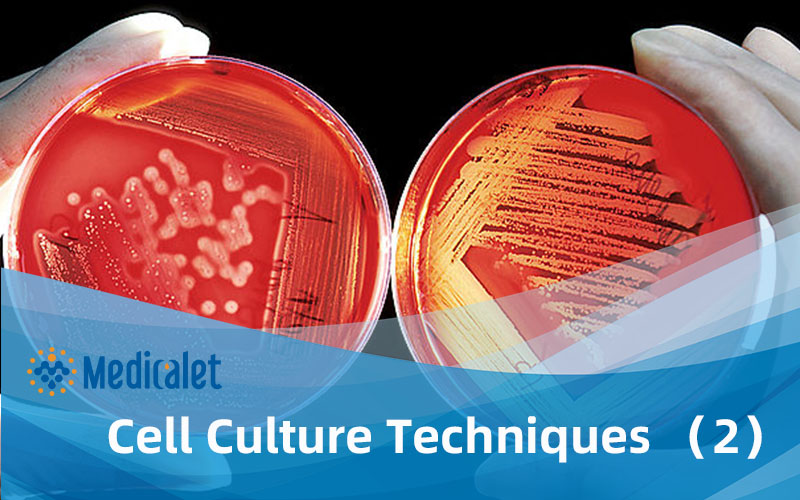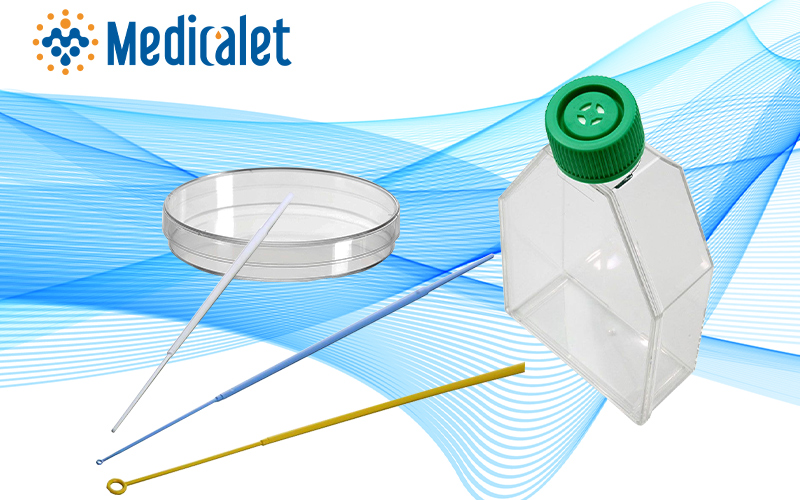
Cryopreservation
Often times, cells are frozen down (i.e. cryopreserved) for various reasons, for example, generating cell stocks to make sure that the culture is not lost due to unexpected equipment failure or biological contaminations. Keeping cells in storage can also eliminate the time, energy and materials that may otherwise be required to maintain cultures not in use. Most importantly, cryopreservation can prevent finite cells from reaching senesce and minimize risks of phenotypic drift due to genetic instability in long term cultures.
i. Freezing Cells
The first step in freezing cells is to collect a cell pellet; depending on whether the cells are adherent cells or suspension cells, there are slightly different protocols. If they are suspension cells, the suspension can simply be collected into a conical tube, spun down in a centrifuge, and collected as a pellet after the media has been removed. If they are adherent cells, the media must be removed and trypsin added to free the cells from the container’s surface, much like in subculturing. After adding serum-containing media to neutralize trypsin, the cells can again be spun down in a tube to collect a pellet .
Once a pellet has been collected, the final step for both adherent and suspension cells is to re-suspend the cells in cryopreservation media. As the cell suspension cools down, the cells will lose water and the concentration of solutes will increase. In addition, ice crystals will form and damage the cells. To prevent loss in viability, cryoprotectant agents such as dimethyl sulphoxide (DMSO) or glycerol are included in the cryopreservation media in order to protect the cells from potential damage caused by ice crystals and osmotic effects . Serum is commonly added as part of the mixture as well to protect the cells from intracellular ice crystals.
A controlled and slow cooling rate, typically at -1˚C per minute, is critical in cryopreservation as it allows water to slowly escape from the cells through osmosis, which in term will minimize ice crystal formation inside the cells. Long term storage of cells require temperatures below -130˚C, usually in a specialized electric freezer or liquid nitrogen freezers. Cells can be stored and recovered decades after it is frozen down.
ii. Thawing Cells
When thawing the cells, the frozen tube of cells is warmed quickly in warm water, rinsed with medium and serum in order to remove the toxic DMSO, and then added into culture containers once suspended in the appropriate media .
Terminology
Cell culturing, much like many other parts of biological research, has its own set of unique vocabulary. Below are some common terms used in cell culturing; familiarity with these will help in understanding any literature and techniques about cell culture.
Adherent cells: Cells that are able to adhere to their culture vessel with the use of an extra-cellular matrix (ECM).
Attachment efficiency: The percentage of cells that actually adhere to the culture vessel’s surface, within a specified period of time, after inoculation.
Aseptic technique: Procedures that are used to prevent contamination of cell, tissue and organ cultures with fungi, bacteria, viruses, mycoplasma and other microorganisms.
Cell culture: The maintenance of cells in vitro outside of their original body.
Cell line: The result of the first subculture of a primary cell line.
Cell strain: Derived from a primary culture or cell line, a cell strain has cells of a specific type with unique properties or markers.

Cryopreservation: The storage of cells, tissues, embryos or seeds in extremely cold temperatures, usually below -130°C.
Epithelial cells: Cells that grow very close together in order to form continuous mosaic-like sheets. When other cells adhere to each other, they are referred to as “epithelial-like cells”.
Fibroblasts: Cells that have a spindle or irregular shape, that a responsible for the formation of fibers. It is often hard to distinguish fibroblasts from others types of cells in cultures, leading to the term “fibroblast-like cells”.
Finite cell culture: A culture that is capable of only a limited number of subculturing rounds, after which the cells cease to proliferate.
Immortalization: Attaining a cell culture that is able to proliferate continuously.
Passage: The transfer of cells from one culture vessel to another. A more specific term is subculturing where the cells are first subdivided before being transferred into multiple cell culture vessels. A passage number will refer specifically to how many times a cell line has been subcultured.
Primary culture: A culture started from cells, tissues or organs that are taken directly from the organism.
Suspension culture: A type of culture where cells multiply while suspended in their liquid medium.
Medicalet can provide you with the best Cell and Tissue culture product. Medicalet laboratory equipment is outstanding in terms of innovation, ergonomic, design and functionality, providing worldwide users efficiency and comfort in their daily work.
If you are interested in our products, please feel free to contact us and ask for samples!
